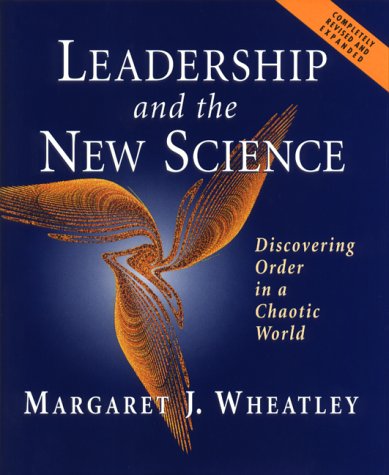Margaret J. Wheatley’s Leadership and the New Science ( San Francisco, CA: Berret-Koehler Publishers, 1999) is one of those books I picked up for a pull quote reference but which wound up as a “keeper†on my bookshelf. It’s a compact work (200 pages) that I return to on occasion and dip into for exploration or as a reminder of deep concepts.
By “new science,” Wheatley means the “new†branches of quantum physics, chaos theory, and biology that are overturning centuries-old models of science. The older science, reflecting the physics of Isaac Newton and the engineering principles developed in the industrial revolution, conceived of the universe as a kind of machine, with its various working parts animated by specific energy sources. It is a mechanistic model of the universe—and of business and, sad to say, congregational organizations—that remains with us today.

In language accessible to non-scientists (she is self-admittedly “not a math person”), Wheatley take readers on a mind-expanding journey into the heart of the new science, examining the discoveries that are exposing as far too simplistic the old concept of “universe as a collection of moving parts.”
Wheatley claims, as many others have, that the Newtonian efforts to explain the workings of the universe were doomed to failure. They were based on the assumption that the universe was something like a glorious “Rube Goldberg” device— a complicated structure in which each step led to the next in predictable cause-and-effect dynamic. In contrast, quantum physics is revealing the universe to be far more complex than a simple collection of physical parts that interact according to predictable laws. Things change form continually, from particles to waves to energy and back again. Magnetic fields interplay with gravitational fields and other forces in constant flux. Seemingly orderly systems respond to new stresses by dissolving and reforming in new patterns. This constant fluidity of motion makes any attempt at identifying fixed structure completely unwarranted, challenging any notions we may desire to hold about the concept of “reality†or certainty.
The bureaucratic structure that organizations have used for so many years was founded directly on the “machine-composed-of-its-parts” metaphor of Newtonian physics, Wheatley claims. Just as the new science has revealed that the machine model cannot illustrate the true nature of the universe, Wheatley claims that the old model of organizations does not truly illuminate what goes on when people come together in organizations.
For example, working from the assumptions of the machine model many who have sought to improve the effectiveness of a business have focused on altering the physical structure of the organization. This has led to failure when attempting organizational change. The new physics offers an entirely different understanding of change in which change is effected by working at the level of identity, rather than just isolating and changing one defective part of the organization.
The tremendously important question that challenges business management today concerns the specific nature of the organizational model that should succeed the dying model of bureaucratic structure and command-and-control management. Wheatley lays down, rather convincingly, the foundations of the new model. She states, “As we struggle with the designs that will replace bureaucracy, we must invent organizations . . . where structures come and go as they support the work that needs to get done, and where forms arise to support the necessary relationships.”
This is a book that can challenge people’s fundamental beliefs about the way the world works. Grappling with the challenging concepts of quantum physics and chaos theory is satisfying and offer frontiers of knowledge that may be among the most significant of this century. Applying these concepts to management and leadership is an interesting enterprise, and Wheatley does it well. At the very least, you may never think about organizational life the same way after reading her book.


Pingback: » Book review: Leadership and the New Science, by Wheatley
Pingback: Book Reviews
Pingback: mul-timedi-a.info
Pingback: biology principles and exploration